
Springbok is the largest town in the Namaqualand area in the Northern Cape province of South Africa. It was called Springbokfontein until 1911, when it was shortened to Springbok. Springbok is located on the N7 national route which connects the Cape with Namibia, and at the western end of the N14, which connects it with Upington and Pretoria. It is the main town of the Nama Khoi Local Municipality, which also includes a number of surrounding towns such as Okiep and Nababeep.

The Succulent Karoo is a ecoregion defined by the World Wide Fund for Nature to include regions of desert in South Africa and Namibia, and a biodiversity hotspot. The geographic area chosen by the WWF for what they call 'Succulent Karoo' does not correspond to the actual Karoo.

The wildlife of South Africa consists of the flora and fauna of this country in southern Africa. The country has a range of different habitat types and an ecologically rich and diverse wildlife, vascular plants being particularly abundant, many of them endemic to the country. There are few forested areas, much savanna grassland, semi-arid Karoo vegetation and the fynbos of the Cape Floristic Region. Famed for its national parks and big game, 297 species of mammal have been recorded in South Africa, as well as 858 species of bird and over 20,000 species of vascular plants.

Namaqua National Park is a South African national park situated approximately 495 km north of Cape Town and 22 km northwest of Kamieskroon. It has an area of more than 1300 km2. The park is part of Namaqualand, an area covering 55,000 km2 located within the semi-desert Succulent Karoo biome. This biome is a biodiversity hotspot with the largest concentration of succulent plants in the world. The park also has an arid environment with succulent plants. The park was created to protect its flowers. During the spring, wildflowers bloom there in a spectacular fashion. The park's main tourist attraction is this abundant spring bloom of brightly coloured wildflowers.

The Anysberg Nature Reserve of 62,500 ha, is situated in the western Little Karoo region of the Gouritz Cluster Biosphere Reserve in the Western Cape province, South Africa. The central mountain is named after Anise, Pimpinella anisum, which is found in the reserve. The reserve was established in 1984, to conserve succulent and fynbos flora in the Cape Fold Belt, and to reintroduce game which formerly occurred here.

Argyroderma is a genus consisting of over 50 species of succulents in the iceplant family from South Africa.

The Albany thickets is an ecoregion of dense woodland in southern South Africa, which is concentrated around the Albany region of the Eastern Cape.
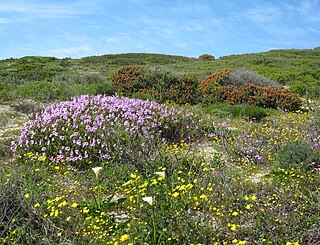
Cape Flats Dune Strandveld is an endangered vegetation type. This is a unique type of Cape Strandveld that is endemic to the coastal areas around Cape Town, including the Cape Flats.

Lapidaria is a monotypic genus of dwarf succulent plants in the family Aizoaceae. The only species it contains is Lapidaria margaretae, also known as the Karoo rose.
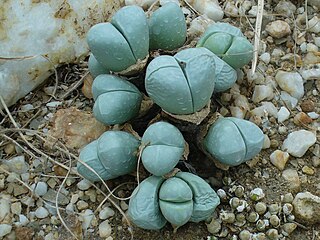
Oophytum is a genus of succulent plants native to South Africa. Both species are endemic to the Knersvlakte. Egg-shaped Oophytum plants develop two leaves opposite each other per season. At the end of winter the outer pair forms a sheath from which the new pair of leaves develop. Water cells are visible on the soft leaves giving them a shimmering appearance. The flowers, produced in winter, are white, pink, or a combination of both.
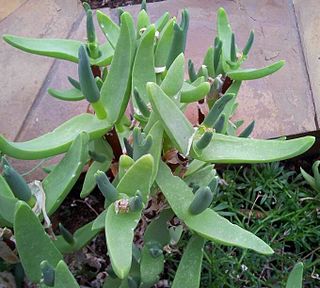
Mitrophyllum is a genus of succulent plants of the family Aizoaceae, indigenous to the arid region around the Richtersveld, on the border of South Africa and Namibia.
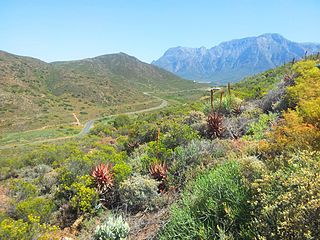
Robertson Karoo is a semi-arid vegetation type, restricted to sections of the Breede River Valley, Western Cape Province, South Africa. It is a subtype of Succulent Karoo and is characterised by the dominance of succulent plant species, and by several endemic plants and animals.
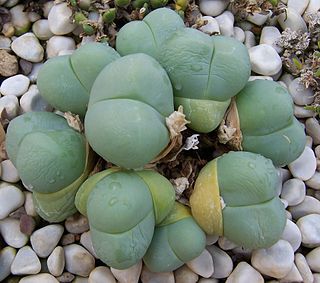
Gibbaeum heathii is a species of succulent plant in the genus Gibbaeum, endemic to South Africa.

Conophytum calculus is a small South African species of succulent plant in the family Aizoaceae.
Bulbine bruynsii is a species of plant in the genus Bulbine. It is endemic to South Africa.
The Gouritz Cluster Biosphere Reserve is located in the Western Cape of South Africa. It is the 7th and largest of South Africa’s biosphere reserves; divided into four connected sectors ranging from sea level to 2,240 metres. The area is the only place in the world where three recognised biodiversity hotspots converge. The site is characterised by high endemism of plant species and threatened invertebrates including seven endemic species of the enigmatic beetle genus Colophon and 14 butterfly species. It provides a migratory route for large mammals such as the leopard and serves as a nursery for marine species.

The Gamkaberg Nature Reserve is situated in the Little Karoo region of the Western Cape province, South Africa.

Argyroderma testiculare is a species of succulents endemic to the quartz gravel of the Knersvlakte region. It belongs to the Aizoaceae family, and is listed as rare on the SANBI Red List, because it occurs in an area smaller than 68 km2, but it is not endangered there.
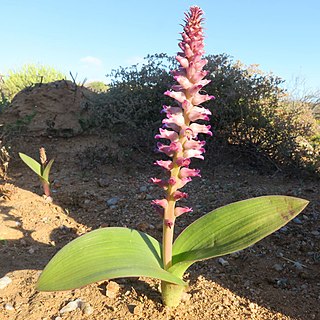
Lachenalia carnosa is a species of geophyte in the genus Lachenalia. It is endemic to the Northern Cape and Western Cape. It is also known by the names namakwa pers viooltjie and flesh viooltjie.


















